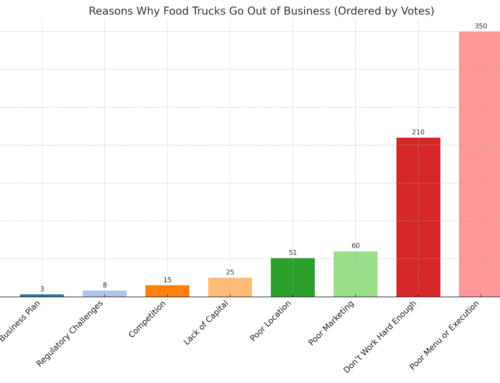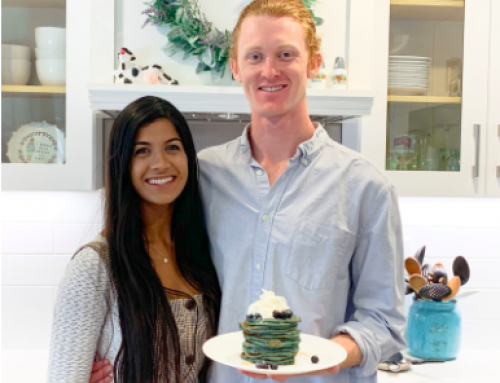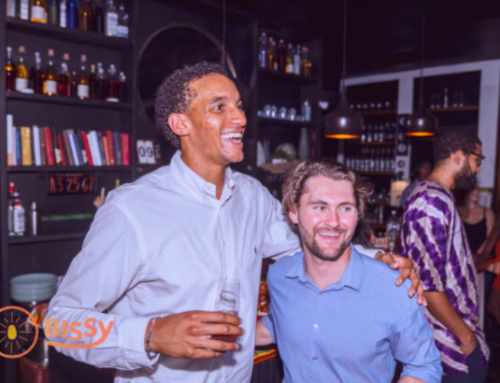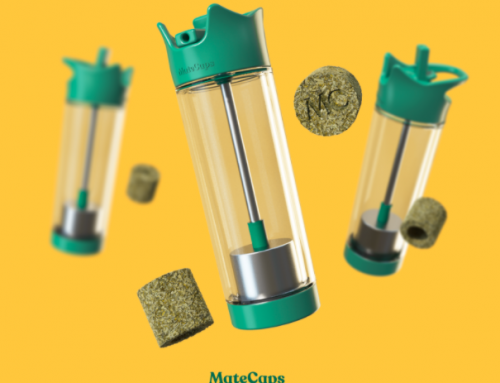Hello! Who are you and what food business did you start?
I’m John Sherwin, one of the cofounders at Hydrant. We make powder drink mixes that combine hydration with other wellness benefits. Our original and flagship product is our rapid hydration mix, and we’ve since launched an Energy product, and an Immunity line.
We’ve grown super fast online via our own website and Amazon, and this year we’ve made the jump into retail as well and you can find Hydrant nationwide at Walmart or at Wholefoods in the Northeast with more retailers to come.
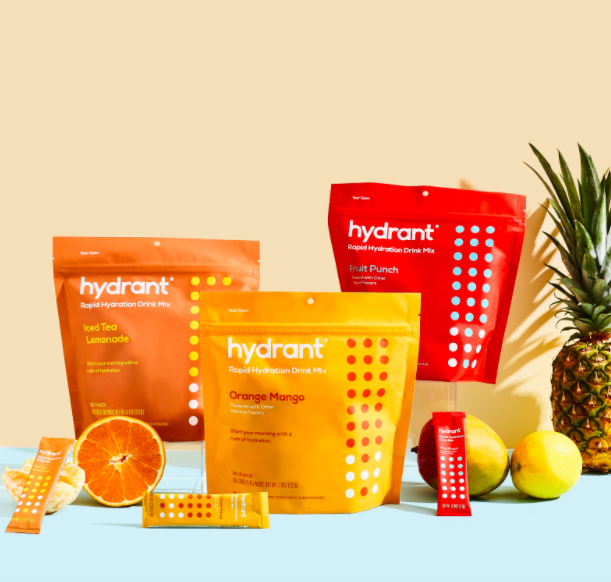
Meet the fastest way to rehydrate.
What do your revenue numbers look like?
In our first year (2018) we did around $40,000 in revenue, partially from our Indiegogo crowdfunding campaign, and the rest from when we opened up our website for ecommerce. Since then our revenue has progressed steadily into millions of dollars each year.
How did you come up with the idea?
My background is in the sciences – I studied Biology at the University of Oxford in the UK, and my first 2 jobs were in research and then making technology tools for scientists.
I first came upon the need for better hydration when I was in college, and found the mix of athletics, studying and socializing very quickly running me down. I noticed the medical students were using these clinical packets of rehydration salts to rehydrate effectively, and tried them out for myself. I felt completely replenished, but they made me gag they were so disgusting. That was the stimulus for learning all about electrolytes, hydration and then trying every product on supermarket shelves to test them out!
When I moved to the USA after college, I tried to find a product better than what we had in the UK, and still fell short. So when I quit my job in tech, I figured it was time to create that product. It helped that shipping powders via ecommerce websites was a very viable business model and way to get product in front of customers. I had absolutely zero experience in food and beverage before this, nor running an ecommerce brand.
Take us through the process of developing Hydrant.
Without experience in the food and beverage industry, I had to rely on experts to get my first iteration of the product off the ground. I spent hours building up the technical specifications for the perfect hydration product, but then signed up with a 3rd party formulation company to make it taste good.
This took way longer than it should have, and in hindsight I would have done a lot more kitchen experimentation before spending any money with these external developers. It took close to 6 months to get the formula to a place that I was happy with, and that ended up needing 2 different formulation partners, one of whom we brought on at the end to make tweaks that would get it to “just right”. Here’s a picture of an early taste testing – humble beginnings!
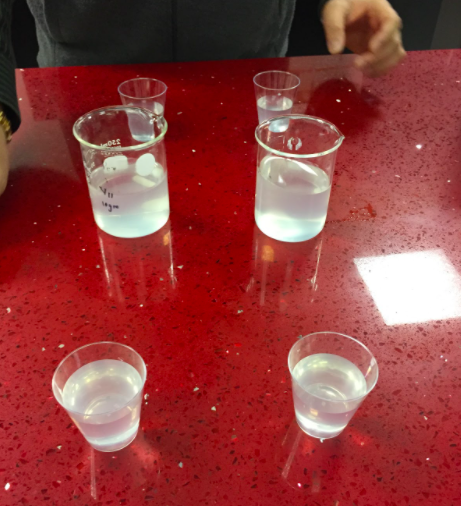
The early taste testing process.
On the brand side I felt a lot more confident in what I wanted, but still hired a good graphic design company to help bring our visual identity to life. This was a fun process, and it’s so satisfying to eventually see your brand in the wild. It took about 3 months so we were able to set up a landing page to start collecting emails, and even some business cards to send out with our early product samples. They still looked pretty sketchy!
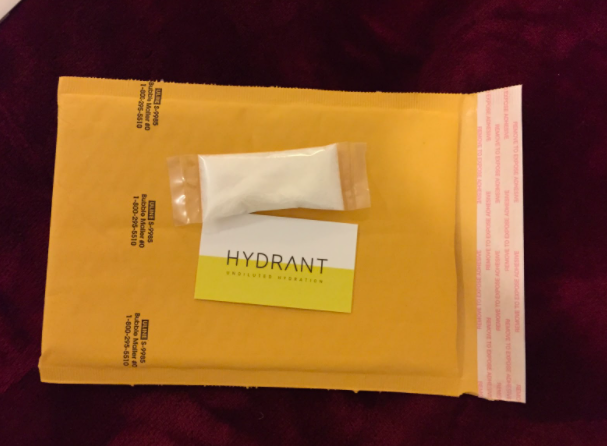
Our early efforts mailing samples.
Other brands in New York and founders who were 1-2 years ahead of me were a phenomenal resource to support the early stages. Introductions to co-packers, packaging designers, regulatory lawyers, regular lawyers etc. The local food and beverage scene was incredibly supportive.
Describe the process of launching Hydrant.
I decided to launch with Indiegogo rather than Kickstarter. There are thousands of articles comparing the pro’s and con’s of each, but what it really boiled down to for me was that Kickstarter had less tools that you could use to run your campaign, but more organic traffic and trust.
Related Reading: How Fat Leaf Water Raised $30k for a Cactus Water Sports Beverage
Indiegogo had less traffic and trust, but you were more empowered to drive your own traffic there so that’s what we did. Looking back, it was not wildly successful at all, but a good first learning experience on how costly digital marketing can be, and on making those first early evangelists your biggest customers in the long run. Some of those customers are still with us today!
From finishing the crowdfunding campaign, it was probably ~4 months until we were able to ship product out to backers. I had lined up a number of friends to help box product and do the packing and shipping. As soon as the last crowdfunding package was out the door, we switched on the website and started to allow ecommerce orders to come in directly. This was a slow trickle for the first few months as we were not driving any traffic with marketing, just word of mouth!

The first warehouse space.
From ideation to actual launch, the biggest learning was to be less of a perfectionist. We spent months honing the formulation to perfection, but as soon as we launched and got real feedback from actual paying customers, we learned we still needed to do a bit of a reformulation. We could have launched 3 months earlier and done the same process.
Since launch, what has worked to attract and retain customers?
Our starting point once we had a bit of capital to invest in marketing was digital marketing, specifically Facebook and Instagram. These are a great tool to quickly test different value propositions, audiences and creatives to figure out how to hone your messaging and targeting. The feedback loop is fast, so one month of testing can get you enough data to dramatically change the way you look at your business, and improve your customer acquisition.

So here’s how it works.
Having a strong grasp of the data available to you here is crucial to your success. How quickly are customers returning? How is it different between the different value propositions? This is really important for us because our product goes beyond just the taste experience, to giving people the feeling of being hydrated. There are multiple moments in the day and use cases when someone might grab a Hydrant, and our messaging would really determine this.
Alongside Facebook and Instagram, we tried some Google Search marketing, hired a small PR firm, and started to really invest in building out our mailing list and SMS list.
These last 2 are crucial to bringing customers back after their first purchase, which is what ultimately determines the health of your business. Especially for a product like Hydrant where the price of each pouch is $30 – $40. We know things are working when customers keep coming back, and now have regulars who have spent thousands of dollars on Hydrant.
In terms of SMS and email marketing, our learning has been that you have to mix good storytelling and brand building with the occasional discount code and sale. If you overdo the sales, no one will buy your product at full price and your brand perception will take a hit.
The brand emails drive long term value, but you won’t see great conversion from them in the short term. In terms of investing time and money in these channels, we’ve always invested in building out robust email flows that are triggered by customer actions.
These are “always on” and you only have to design the email once and occasionally refresh it. When sending campaigns, you have to design the email from scratch each time and once it’s sent you can’t really use it again.
Related Reading: 37 Sports Drink Market Share Statistics and Demographics
One mistake we made early on, was not pushing our subscription option more aggressively. We came online at a time when consumers were getting more comfortable and even seeking out subscriptions over one-off purchases. Really making it clear what value someone could get from subscribing helped us to increase our repeat purchase rate which helped us to scale aggressively.
After a few months honing our messaging and operations through our own website, we set up our Amazon account and started selling there in order to reach a broader audience, and make buying Hydrant even easier. Amazon can be a big decision for small brands, but we’re sure it was the right one for us at that time and have grown it to be a good chunk of our revenues.
How are you doing today and what does the future look like?

Cheers!
Today, we’re a team of 15 people and counting, working remotely from all over the country as we navigate life during a pandemic. Our retail presence is rapidly growing as we focus on building out that channel, and our ecommerce business both on our own website and on other platforms continues to grow at an exceptional rate as we reach more customers.
Our team is split into a few buckets: Creative, Growth, Retail, Operations, Finance and Customer Experience, and there is a lot of cross functional work as we are still relatively lean!
In terms of our operations, the biggest change as we have grown is that we are no longer a tiny company with no negotiating power with our various suppliers. This means that we get more responsiveness and generally a better service level than in the early days. We still have many of the same suppliers we started out with – they took a bet on us when we were small, so it feels great to be able to grow with them.
Through starting Hydrant, what lessons have you learned?
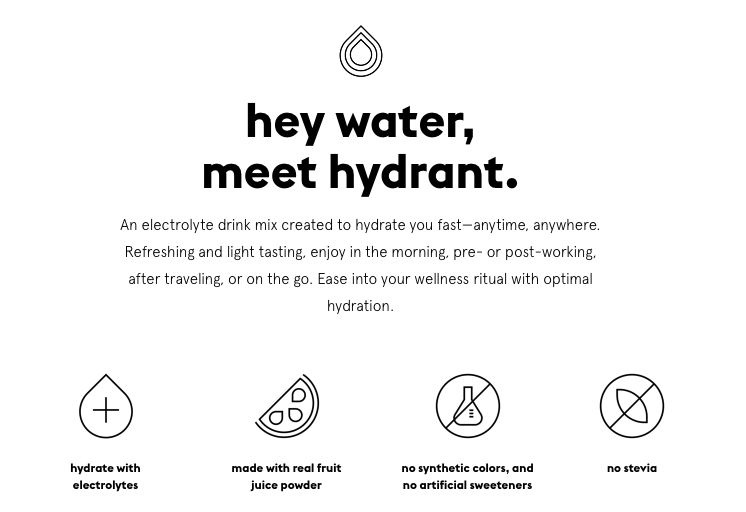
Hey water, meet Hydrant.
I think most of the business books I read prior to starting Hydrant had good advice in them that I more or less ignored or assumed was just a tired cliche. Now, having been through it myself, I realize there is a good reason it seems like a tired cliche: it’s true. Here are some examples:
- Don’t wait too long to launch – I already mentioned this one, but being a perfectionist on products/marketing campaigns etc. leads to slow progress
- Don’t hire for experience in the early days, hire for attitude and learning aptitude. A bonus learning here was to leverage experienced advisors to then guide the sheer energy of a motivated team in the right direction.
- You will never think you need a well written contract when starting a relationship with a new vendor or partner. The upfront cost of getting every contract reviewed will pay off many times over instead of signing one bad contract.
Luck is a huge factor in starting a business. It’s important to put yourselves in positions where you can get “lucky”. For example, I started out on my own and knew that to grow Hydrant fast enough to ride the wave in the hydration space I wanted a cofounder, preferably one with a very different skill set to my own.
I put up various job postings for cofounders on angel list and posted them on social networks so that the right person might eventually see it. Lucky for me my now cofounder, Jai, saw one and had been wanting to start something in the same space so we joined forces and the rest is history.
Something we’ve learned is that you have to play to win, not play to “not lose”. We’re trying to our grow our business fast, and that involves taking some risk on. In particular something we’ve done is identified a few concentrated marketing bets to make. Some of these have been hard lessons and big failures, but as long as we learn from them and use that to drive future marketing efforts it’s worth it!
What key tools do you use in your business?
Shopify is the backbone of our ecommerce business, and I’d recommend it to anyone trying to build a scalable ecommerce business. It’s very robust, so we can trust it to handle our volume even when we’re growing fast. It’s mostly a “set it and forget it” type tool. Other than that, Klaviyo is another tool that we love internally, allowing us to build more complex post-purchase email flows than other email marketing tools we looked at.
In the early days of Hydrant, when I was weighing and measuring lots of powder into both large and small bags a like, the workhorse of the operation was my heat sealer. We still have it at the office, but it gets a lot less use as we’re rarely formulating at our office these days!
Any books you recommend reading?
Shoe Dog by Phil Knight is the story of Nike. It’s probably the most enjoyable business book I’ve read, as it’s structured in narrative form, and a really compelling story.
How I built this was a podcast that was very influential early on at Hydrant. Hearing about the perseverance of these successful founders was really inspiring, especially when working through the months of preparation for launch. Now that we’re launched, I don’t listen anymore – we’re doing it ourselves!
Advice for other food entrepreneurs just starting out?
Connect with your local food and beverage network. This could be through networking events, through conferences or simply through reaching out to business owners. People like to help each other in this industry, and we have been helped countless times by local friends in the same industry. I am still friendly with people I met at my first beverage conference, and we help each other out regularly.
Early on, get really comfortable with what type of business you’re trying to build. If you’re trying to build slowly and sustainably, don’t take investment. If you want to grow faster, raise money and get ready to learn a lot, very quickly. Both approaches are great, but you should know which one you are shooting for and be comfortable with the different paths.
This one is a bit out of left field: 3D renders. You will be SHOCKED by how many of the big brands are just using really good renders in all of their photography. It’s a relatively cheap way to get a lot of different shots that look 100% perfect.

